Pashtuns
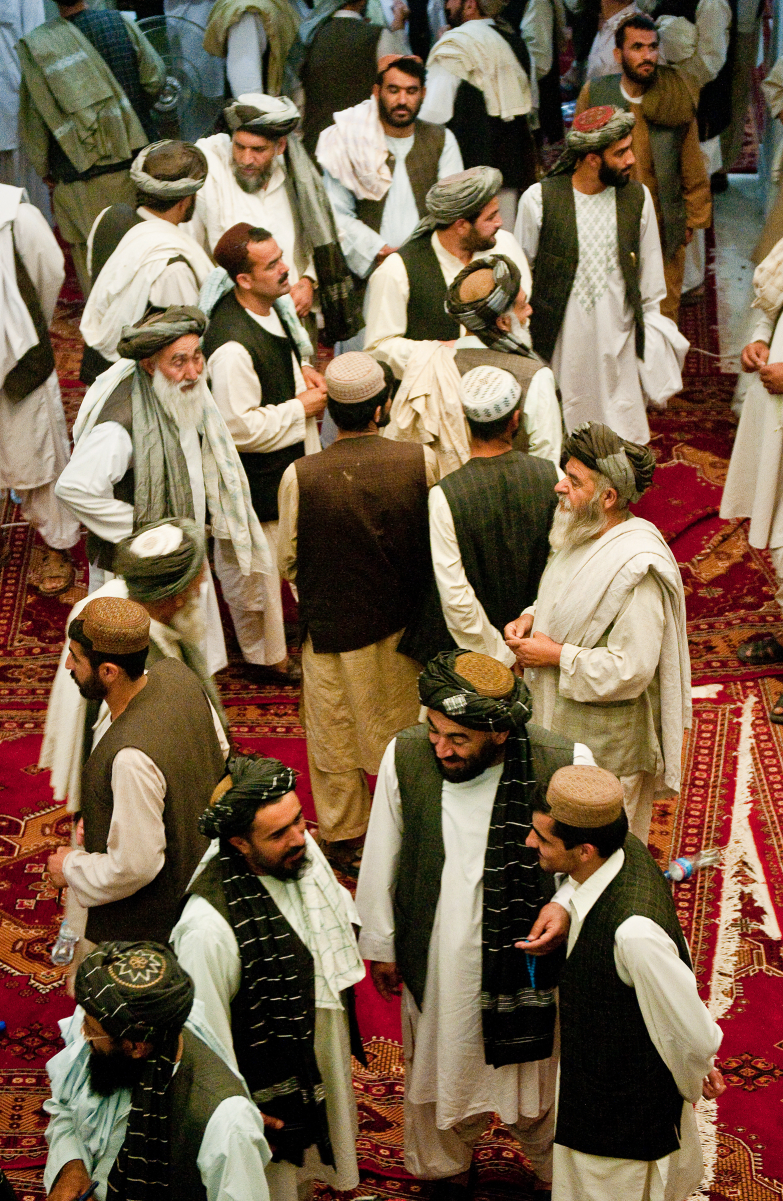
Pashtuns

| Total population | |
|---|---|
| 50 million | |
| Regions with significant populations | |
| 32,804,913 (2018)[3] | |
| 14,675,151 (2018)[4] | |
| 3,200,000[5] | |
| UAE | 338,315 (2009)[6] |
| 138,554 (2010)[7] | |
| Iran | 110,000 (1993)[8] |
| 100,000 (2009)[9] | |
| 37,800 (2012)[10] | |
| 26,000 (2006)[11] | |
| 9,800 (2002)[12] | |
| 8,154 (2006)[13] | |
| 5,500 (2008) | |
| Tajikistan | 4,000 (1970)[8] |
| Finland | 1,181[14] |
| Languages | |
| Pashto*Minor:Dari(in Afghanistan),Urdu(in Pakistan and India),Punjabi,Hindko,Ormuri,Dardic,Balochi | |
| Religion | |
| Islam (Sunni) | |
The Pashtuns (/ˈpʌʃˌtʊn/, /ˈpɑːʃˌtʊn/ or /ˈpæʃˌtuːn/; Pashto: پښتانه, Pax̌tānə; also Pukhtuns), historically known as ethnicAfghans[1] or Pathans [2] are an Iranian-speaking ethnic group[23] native to South-Central Asia,[24] who share a common history and culture. A substantial majority of ethnic Pashtuns shares Pashto, an Eastern Iranian language in the Indo-European language family as the native language.
Globally, the Pashtuns are estimated to number around 50 million,[25] but an accurate count remains elusive due to the lack of an official census in Afghanistan since 1979.
The majority of the Pashtuns live in the region regarded as Pashtunistan, which has been split between two countries since the Durand Line border was formed after the Second Anglo-Afghan War.[26] There are also significant Pashtun diaspora communities in Sindh and Punjab in Pakistan, especially in the cities of Karachi and Lahore, and in the Rohilkhand region of Uttar Pradesh, India. A recent Pashtun diaspora has also developed in the Arab states of the Persian Gulf, primarily in the United Arab Emirates. The Pashtuns are a significant minority group in Pakistan, where they constitute the second-largest ethnic group or about 15% of the population. As the largest ethnic group in Afghanistan (anywhere between 42 and 60 percent of the population), Pashtuns have been the dominant ethno-linguistic group for over 300 years. During the Delhi Sultanate era, the 15th–16th century Lodi dynasty briefly replaced the preexisting rulers in North India until Babur completely deposed the Lodi dynasty. Other Pashtuns fought the Safavids and Mughals before obtaining an independent state in the early 18th century,[27] which began with a successful revolution by Mirwais Hotak followed by conquests of Ahmad Shah Durrani.[28] The Barakzai dynasty played a vital role during the Great Game from the 19th century to the 20th century as they were caught between the imperialist designs of the British and Russian empires.
The Pashtuns are the world's largest segmentary lineage ethnic group. Estimates of the number of Pashtun tribes and clans range from about 350 to over 400.[27][29] There have been many notable Pashtun people throughout history: Ahmad Shah Durrani is regarded as the founder of the modern state of Afghanistan, while Bacha Khan was a Pashtun independence activist against the rule of the British Raj. Some others include Imran Khan, Malala Yousafzai, Shahid Afridi, Shah Rukh Khan, Zarine Khan, Farhad Darya, Abdul Ahad Mohmand, Naghma, Ahmad Zahir, Zakir Husain, Hamid Karzai, Ashraf Ghani, and Mullah Mohammed Omar.
| Total population | |
|---|---|
| 50 million | |
| Regions with significant populations | |
| 32,804,913 (2018)[3] | |
| 14,675,151 (2018)[4] | |
| 3,200,000[5] | |
| UAE | 338,315 (2009)[6] |
| 138,554 (2010)[7] | |
| Iran | 110,000 (1993)[8] |
| 100,000 (2009)[9] | |
| 37,800 (2012)[10] | |
| 26,000 (2006)[11] | |
| 9,800 (2002)[12] | |
| 8,154 (2006)[13] | |
| 5,500 (2008) | |
| Tajikistan | 4,000 (1970)[8] |
| Finland | 1,181[14] |
| Languages | |
| Pashto*Minor:Dari(in Afghanistan),Urdu(in Pakistan and India),Punjabi,Hindko,Ormuri,Dardic,Balochi | |
| Religion | |
| Islam (Sunni) | |
Geographic distribution
The vast majority of the Pashtuns are found in the traditional Pashtun homeland, located in an area south of the Amu Darya in Afghanistan and west of the Indus River in Pakistan, which includes Khyber Pakhtunkhwa and the northern part of Balochistan. Additional Pashtun communities are located in Western and Northern Afghanistan, the Gilgit–Baltistan and Kashmir regions and northwestern Punjab province (Mianwali and Attock), Pakistan. There are also sizeable Muslim communities in India, which are of largely Pashtun ancestry.[30][31][5] Throughout the Indian subcontinent, they are often referred to as Pathans.[32] Smaller Pashtun communities are found in the countries of the Middle East, such as in the Khorasan Province of Iran, the Arabian Peninsula, Europe, North America and Australia.
Important metropolitan centres of Pashtun culture include Peshawar, Kabul, Quetta, Kandahar, Mardan, Mingora and Jalalabad. In Pakistan, the city of Karachi in Sindh province has the largest Pashtun diaspora communities in the world, with as much as 7 million Pashtuns living in Karachi according to some estimates.[33][34] Several cities in Pakistan's Punjab province also have sizeable Pashtun populations, in particular Lahore.
About 15%[3][36] of Pakistan's nearly 200 million population is Pashtun. In Afghanistan, they are the largest ethnic group and make up between 42–60% of the 32.5 million population.[38] The exact figure remains uncertain in Afghanistan, which is also affected by the 1.3 million or more Afghan refugees that remain in Pakistan, a majority of which are Pashtuns. Another one million or more Afghans live in Iran. A cumulative population assessment suggests a total of around 49 million individuals all across the world.[25]
Tribes
A prominent institution of the Pashtun people is the intricate system of tribes. The Pashtuns remain a predominantly tribal people, but the trend of urbanisation has begun to alter Pashtun society as cities such as Kandahar, Peshawar, Quetta and Kabul have grown rapidly due to the influx of rural Pashtuns. Despite this, many people still identify themselves with various clans.
The tribal system has several levels of organisation: the tribe, tabar, is divided into kinship groups called khels, in turn divided into smaller groups (pllarina or plarganey), each consisting of several extended families called kahols.[39] Pashtun tribes are divided into four 'greater' tribal groups: the Sarbani, the Bettani, the Gharghashti, and the Karlani.
History and origins

Tents of Afghan nomads in Badghis Province who are known in Pashto language as Kuchian. They migrate from region to region depending on the season (transhumance).[40]
Excavations of prehistoric sites suggest that early humans were living in what is now Afghanistan at least 50,000 years ago.[41] Since the 2nd millennium BC, cities in the region now inhabited by Pashtuns have seen invasions and migrations, including by Ancient Indian peoples, Ancient Iranian peoples, the Medes, Persians, and Ancient Macedonians in antiquity, Kushans, Hephthalites, Arabs, Turks, Mongols, and others. In recent times, people of the Western world have explored the area as well.[41][42][43]
The ethnogenesis of the Pashtun ethnic group is unclear but historians have come across references to various ancient peoples called Pakthas (Pactyans) between the 2nd and the 1st millennium BC,[44][45] who may be their early ancestors. There are many conflicting theories, some modern and others archaic, both among historians and the Pashtuns themselves.[46]
"... the origin of the Afghans is so obscure, that no one, even among the oldest and most clever of the tribe, can give satisfactory information on this point."[47]
"Looking for the origin of Pashtuns and the Afghans is something like exploring the source of the Amazon. Is there one specific beginning? And are the Pashtuns originally identical with the Afghans? Although the Pashtuns nowadays constitute a clear ethnic group with their own language and culture, there is no evidence whatsoever that all modern Pashtuns share the same ethnic origin. In fact it is highly unlikely."[48]
Early precursors to some of the Pashtun's may have been old Iranian tribes that spread throughout the eastern Iranian plateau.[49] According to Yu. V. Gankovsky, the Pashtun's probably began as a "union of largely East-Iranian tribes which became the initial ethnic stratum of the Pashtun ethnogenesis, dates from the middle of the first millennium CE and is connected with the dissolution of the Epthalites (White Huns) confederacy." He proposes Ephthalite origin for Pashtuns[50][51] but others draw a different conclusion. According to Abdul Hai Habibi, some oriental scholars hold that the second largest Pasthun tribe, the Ghiljis, are the descendants of a mixed race of Hephthalite and Pakhtas who have been living in Afghanistan since the Vedic Aryan period.[40]
Pashtuns are intimately tied to the history of modern Afghanistan, Iran, Pakistan and northern India.
Following Muslim conquests from the 7th to 11th centuries, many Pashtun ghazis (warriors) invaded and conquered much of the northern parts of South Asia during the periods of the Suris and Durranis.
Ancient references

The Arachosia Satrapy and the Pactyan people during the Achaemenid Empire in 500 BCE
Some modern-day Pashtun tribes have also been identified living in ancient Ariana (e.g., Alexander's historians mentioned "Aspasii" in 330 BC and that may refer to today's Afridis or to the Yusufzai).[52] In the Middle Ages until the advent of modern Afghanistan in the 18th century and the division of Pashtun territory by the 1893 Durand Line, Pashtuns were often referred to as ethnic "Afghans". The earliest mention of the name Afghan (Abgân) is by Shapur I of the Sassanid Empire during the 3rd century CE,[17][53][54] which is later recorded in the 6th century CE in the form of "Avagānā" by the Indian astronomer Varāha Mihira in his Brihat-samhita.[55] It was used to refer to a common legendary ancestor known as Afghana", propagated to be grandson of King Saul of Israel.[46]
Xuanzang, a Chinese Buddhist pilgrim, visiting the Afghanistan region several times between 630 and 644 CE also speaks about them.[17][56] In Shahnameh 1–110 and 1–116, it is written as Awgaan.[17] Ancestors of many of today's Turkic-speaking Afghans settled in the Hindu Kush area and began to assimilate much of the culture and language of the Pashtun tribes already present there.[57] Among these were the Khalaj people who are known today as Ghilji.[58] According to several scholars such as V. Minorsky, the name "Afghan" is documented several times in the 982 CE Hudud-al-Alam.[54]
"Saul, a pleasant village on a mountain.
In it live Afghans".[48]— Hudud ul-'alam, 982 CE
The village of Saul was probably located near Gardez in Afghanistan. Hudud ul-'alam also speaks of a king in Ninhar (Nangarhar), who had Muslim, Afghan and Hindu wives.[59] Al-Biruni wrote about Afghans in the 11th century as various tribes living in the western mountains of India and extending to the region of Sind. It was reported that between 1039 and 1040 CE Mas'ud I of the Ghaznavid Empire sent his son to subdue a group of rebel Afghans near Ghazni. An army of Arabs, Afghans, Khiljis and others was assembled by Arslan Shah Ghaznavid in 1119 CE. Another army of Afghans and Khiljis was assembled by Bahram Shah Ghaznavid in 1153 CE. Muhammad of Ghor, ruler of the Ghorids, also had Afghans in his army along with others.[60] A famous Moroccan travelling scholar, Ibn Battuta, visiting Afghanistan following the era of the Khalji dynasty in early 1300s gives his description of the Afghans.
"We travelled on to Kabul, formerly a vast town, the site of which is now occupied by a village inhabited by a tribe of Persians called Afghans. They hold mountains and defiles and possess considerable strength, and are mostly highwaymen. Their principle mountain is called Kuh Sulayman. It is told that the prophet Sulayman (Solomon), Sulemani ascended this mountain and having looked out over India, which was then covered with darkness, returned without entering it."[61]— Ibn Battuta, 1333
Muhammad Qasim Hindu Shah (Ferishta), writes about Afghans and their country called Afghanistan
"The men of Kábul and Khilj also went home; and whenever they were questioned about the Musulmáns of the Kohistán (the mountains), and how matters stood there, they said, "Don't call it Kohistán, but Afghánistán; for there is nothing there but Afgháns and disturbances." Thus it is clear that for this reason the people of the country call their home in their own language Afghánistán, and themselves Afgháns. The people of India call them Patán; but the reason for this is not known. But it occurs to me, that when, under the rule of Muhammadan sovereigns, Musulmáns first came to the city of Patná, and dwelt there, the people of India (for that reason) called them Patáns—but God knows!"[62]— Ferishta, 1560–1620
One historical account connects the native Pakhtuns of Pakistan to a possible Ancient Egyptian past but this lacks supporting evidence.[63]
"I have read in the Mutla-ul-Anwar, a work written by a respectable author, and which I procured at Burhanpur, a town of Khandesh in the Deccan, that the Afghans are Copts of the race of the Pharaohs; and that when the prophet Moses got the better of that infidel who was overwhelmed in the Red Sea, many of the Copts became converts to the Jewish faith; but others, stubborn and self-willed, refusing to embrace the true faith, leaving their country, came to India, and eventually settled in the Sulimany mountains, where they bore the name of Afghans."[17]— Ferishta, 1560–1620
Additionally, although this too is unsubstantiated, some Afghan historians have maintained that Pashtuns are linked to the ancient Israelites. Mohan Lal quoted Mountstuart Elphinstone who wrote:
"The Afghan historians proceed to relate that the children of Israel, both in Ghore and in Arabia, preserved their knowledge of the unity of God and the purity of their religious belief, and that on the appearance of the last and greatest of the prophets (Muhammad) the Afghans of Ghore listened to the invitation of their Arabian brethren, the chief of whom was Khauled...if we consider the easy way with which all rude nations receive accounts favourable to their own antiquity, I fear we much class the descents of the Afghans from the Jews with that of the Romans and the British from the Trojans, and that of the Irish from the Milesians or Brahmins."[64]— Mountstuart Elphinstone, 1841
Henry Walter Bellew concluded in 1864 that the Pashtuns likely have mixed Greek and Indian Rajput roots.[65][66][67] Following Alexander's brief occupation, the successor state of the Seleucid Empire expanded influence on the Pashtuns until 305 BCE when they gave up dominating power to the Indian Maurya Empire as part of an alliance treaty.[68]
Anthropology and oral traditions
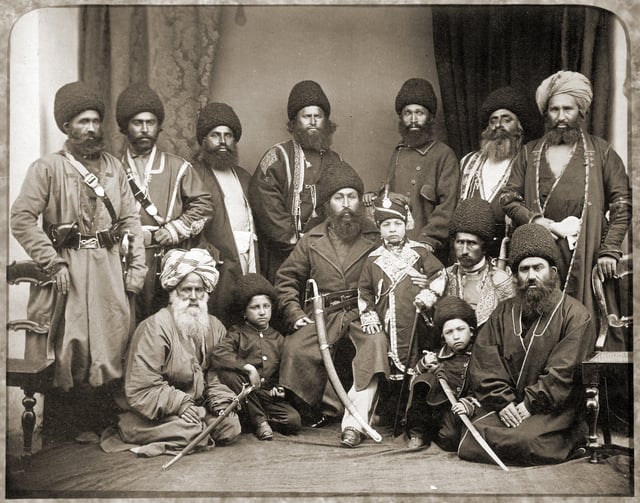
Afghan Amir Sher Ali Khan (in the center with his son) and his delegation in Ambala, near Lahore, in 1869
Some Pashtun tribes claim descent from Arabs, including some claiming to be Sayyids (descendants of Muhammad).[69] Some groups from Peshawar and Kandahar believe to be descended from Greeks who arrived with Alexander the Great.[70] Pashto is classified under the Eastern Iranian sub-branch of the Iranian branch of the Indo-European language family. Those who speak a dialect of Pashto in the Kandahar region refer to themselves as Pashtuns, while those who speak a Peshawari dialect call themselves Pukhtuns. These native people compose the core of ethnic Pashtuns who are found in southeastern Afghanistan and western Pakistan. The Pashtuns have oral and written accounts of their family tree. The elders transfer the knowledge to the younger generation. Lineage is considered very important and is a vital consideration in marital business.
Theory of Pashtun descent from Israelites
Some anthropologists lend credence to the oral traditions of the Pashtun tribes themselves. For example, according to the Encyclopaedia of Islam, the theory of Pashtun descent from Israelites is traced to Nimat Allah al-Harawi, who compiled a history for Khan-e-Jehan Lodhi in the reign of Mughal Emperor Jehangir in the 17th century.[71] The 13th century Tabaqat-i Nasiri discusses the settlement of immigrant Bani Israel at the end of the 8th century CE in the Ghor region of Afghanistan, settlement attested by Jewish inscriptions in Ghor. Historian André Wink suggests that the story "may contain a clue to the remarkable theory of the Jewish origin of some of the Afghan tribes which is persistently advocated in the Persian-Afghan chronicles."[72] These references to Bani Israel agree with the commonly held view by Pashtuns that when the twelve tribes of Israel were dispersed, the tribe of Joseph, among other Hebrew tribes, settled in the Afghanistan region.[73] This oral tradition is widespread among the Pashtun tribes. There have been many legends over the centuries of descent from the Ten Lost Tribes after groups converted to Christianity and Islam. Hence the tribal name Yusufzai in Pashto translates to the "son of Joseph". A similar story is told by many historians, including the 14th century Ibn Battuta and 16th century Ferishta.[17]
One conflicting issue in the belief that the Pashtuns descend from the Israelites is that the Ten Lost Tribes were exiled by the ruler of Assyria, while Maghzan-e-Afghani says they were permitted by the ruler to go east to Afghanistan. This inconsistency can be explained by the fact that Persia acquired the lands of the ancient Assyrian Empire when it conquered the Empire of the Medes and Chaldean Babylonia, which had conquered Assyria decades earlier. But no ancient author mentions such a transfer of Israelites further east, or no ancient extra-Biblical texts refer to the Ten Lost Tribes at all.
Modern era
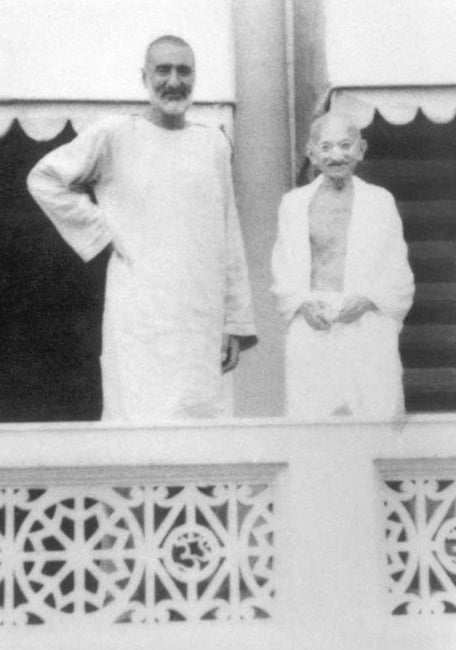
Leader of the non-violent Khudai Khidmatgar, also referred to as "the Red shirts" movement, Bacha Khan, standing with Mohandas Gandhi

Zalmay Khalilzad with George W. Bush inside the White House
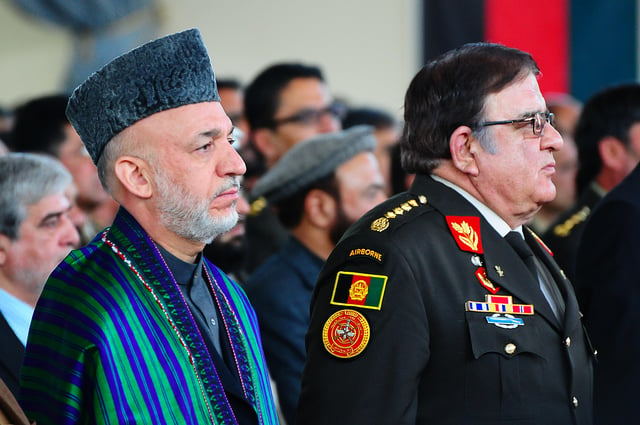
President Hamid Karzai and Abdul Rahim Wardak

President Ayub Khan in 1972
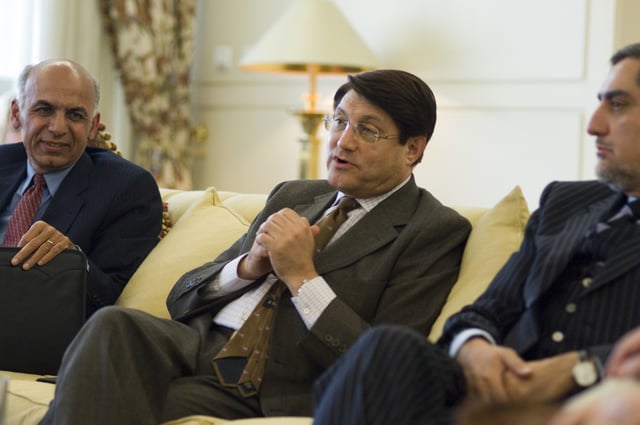
From left to right: Ashraf Ghani Ahmadzai; Anwar ul-Haq Ahady; and Abdullah Abdullah
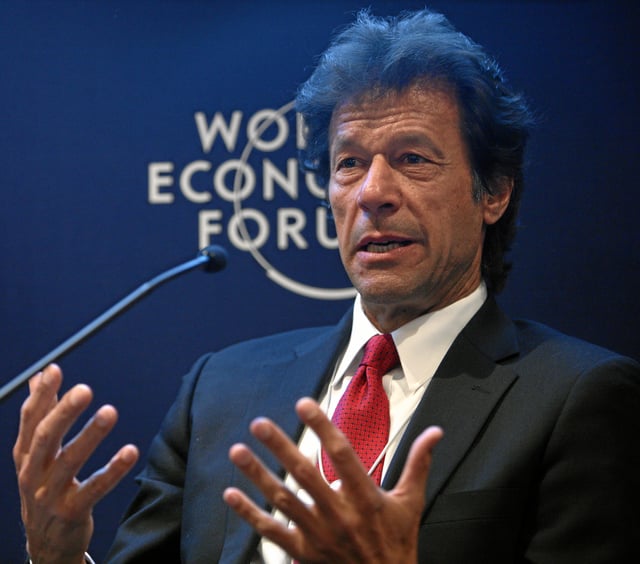
Imran Khan, Pakistani cricketer-turned-politician and the current Prime Minister, belongs to the Niazi tribe.
Their modern past stretches back to the Delhi Sultanate, particularly the Hotak dynasty and the Durrani Empire. The Hotaks were Ghilji tribesmen who rebelled against the Safavids and seized control over much of Persia from 1722 to 1729.[74] This was followed by the conquests of Ahmad Shah Durrani who was a former high-ranking military commander under Nader Shah. He created the last Afghan empire that covered most of what is now Afghanistan, Pakistan, Kashmir, Indian Punjab, as well as the Kohistan and Khorasan provinces of Iran.[28] After the decline of the Durrani dynasty in the first half of the 19th century under Shuja Shah Durrani, the Barakzai dynasty took control of the empire. Specifically, the Mohamedzai subclan held Afghanistan's monarchy from around 1826 to the end of Zahir Shah's reign in 1973. Former President Hamid Karzai is from the Popalzai tribe of Kandahar.
The Pashtuns in Afghanistan resisted British designs upon their territory and kept the Russians at bay during the so-called Great Game. By playing the two super powers against each other, Afghanistan remained an independent sovereign state and maintained some autonomy (see the Siege of Malakand). But during the reign of Abdur Rahman Khan (1880–1901), Pashtun regions were politically divided by the Durand Line, and what is today western Pakistan was claimed by British in 1893. In the 20th century, many politically active Pashtun leaders living under British rule of undivided India supported Indian independence, including Ashfaqulla Khan,[75]The%20Contemporary%2C%20Vol]] Abdul Samad Khan Achakzai Ajmal Khattak Bacha Khan Wali Khan Khudai Khidmatgar Mohandas Gandhi non-violent[77][78] tuns also worked in the Muslim League to fight for an independent Pakistan, including Yusuf Khattak and Abdur Rab Nishtar who was a close associate of Muhammad Ali Jinnah.[79]
The Pashtuns of Afghanistan attained complete independence from British political intervention during the reign of Amanullah Khan, following the Third Anglo-Afghan War. By the 1950s a popular call for Pashtunistan began to be heard in Afghanistan and the new state of Pakistan. This led to bad relations between the two nations. The Afghan monarchy ended when President Daoud Khan seized control of Afghanistan from his cousin Zahir Shah in 1973, which opened doors for a proxy war by neighbors and the rise of Marxism. In April 1978, Daoud Khan was assassinated along with his family and relatives. Mujahideen commanders began being recruited in neighboring Pakistan for a guerrilla warfare against the Democratic Republic of Afghanistan. In 1979, the Soviet Union invaded its southern neighbor Afghanistan in order to defeat a rising insurgency. The mujahideen were funded by the United States, Saudi Arabia, Iran and others, and included some Pashtun commanders such as Gulbuddin Hekmatyar and Jalaluddin Haqqani, who are currently waging an insurgency against the Islamic republic of Afghanistan and the US-led Resolute Support Mission. In the meantime, millions of Pashtuns fled their native land to live among other Afghan diaspora in Pakistan and Iran, and from there tens of thousands proceeded to North America, the European Union, the Middle East, Australia and other parts of the world.
In the late 1990s, Pashtuns became known for being the primary ethnic group comprised by the Islamic Emirate of Afghanistan (Taliban regime).[80] The Northern Alliance that was fighting against the Taliban also included a number of Pashtuns. Among them were Abdullah Abdullah, Abdul Qadir and his brother Abdul Haq, Abdul Rasul Sayyaf, Asadullah Khalid, Hamid Karzai and Gul Agha Sherzai. The Taliban regime was ousted in late 2001 during the US-led War in Afghanistan and replaced with the Karzai administration.[81] This was followed by the Ghani administration.
Many high-ranking government officials in Afghanistan are Pashtuns, including: Zalmay Rasoul, Abdul Rahim Wardak, Omar Zakhilwal, Ghulam Farooq Wardak, Anwar ul-Haq Ahady, Yousef Pashtun and Amirzai Sangin. The list of current governors of Afghanistan, as well as the parliamentarians in the House of the People and House of Elders, include large percentage of Pashtuns. The Chief of staff of the Afghan National Army, Sher Mohammad Karimi, and Commander of the Afghan Air Force, Mohammad Dawran, as well as Chief Justice of Afghanistan Abdul Salam Azimi and Attorney General Mohammad Ishaq Aloko also belong to the Pashtun ethnic group.
Pashtuns not only played an important role in South Asia but also in Central Asia and the Middle East.
Many of the non-Pashtun groups in Afghanistan have adopted the Pashtun culture and use Pashto as a second language.
For example, many leaders of non-Pashtun ethnic groups in Afghanistan practice Pashtunwali to some degree and are fluent in Pashto language.
These include Ahmad Shah Massoud, Ismail Khan, Mohammed Fahim, Bismillah Khan Mohammadi, and many others. The Afghan royal family, which was represented by King Zahir Shah, belongs to the Mohammadzai tribe of Pashtuns. Other prominent Pashtuns include the 17th-century poets Khushal Khan Khattak and Rahman Baba, and in contemporary era Afghan Astronaut Abdul Ahad Mohmand, former U.S. Ambassador to the United Nations Zalmay Khalilzad, and Ashraf Ghani Ahmadzai among many others.
Many Pashtuns of Pakistan have adopted non-Pashtun cultures, and learned other languages such as Hindi-Urdu, Balochi or Hindko.[82] These include Ayub Khan, Yahya Khan, and Ghulam Ishaq Khan, who attained the Presidency. Ghulam Mohammad became the Governor-General of Pakistan from 1951 to 1955. Many more held high government posts, such as Aftab Ahmad Sherpao, Fazal-ur-Rehman (politician), and Asfandyar Wali Khan, who represents Awami National Party (ANP) in Pakistan. Others became famous in sports (e.g., Imran Khan, Shahid Afridi, Jahangir Khan, and Jansher Khan) and literature (e.g., Ghani Khan, Ameer Hamza Shinwari, Munir Niazi, and Omer Tarin). Malala Yousafzai, who became the youngest Nobel Peace Prize recipient in 2014, is a Pakistani Pashtun.
Pashtun families are historically accustomed to watching Indian films and dramas.[83] This is due to cultural similarities.
Many of the Bollywood film stars in India have Pashtun ancestry; some of the most notable ones are Aamir Khan, Shahrukh Khan, Salman Khan, Feroz Khan, Saif Ali Khan, Madhubala, Kader Khan, and Zarine Khan. In addition, one of India's former presidents, Zakir Hussain, belonged to the Afridi tribe.[84][85][86] Mohammad Yunus, India's former ambassador to Algeria and advisor to Indira Gandhi, is of Pashtun origin and related to the legendary Bacha Khan.[87][88][89][90]
Genetics
According to a 2012 study:
MDS and Barrier analysis have identified a significant affinity between Pashtun, Tajik, North Indian, and Western Indian populations, creating an Afghan-Indian population structure that excludes the Hazaras, Uzbeks, and the South Indian Dravidian speakers. In addition, gene flow to Afghanistan from India marked by Indian lineages, L-M20, H-M69, and R2a-M124, also seems to mostly involve Pashtuns and Tajiks. This genetic affinity and gene flow suggests interactions that could have existed since at least the establishment of the region's first civilizations at the Indus Valley and the Bactria-Margiana Archaeological Complex.
According to a 2012 study:
MDS and Barrier analysis.
The gene flow to Afghanistan from India marked by Indian lineages L-M20, H-M69 and R2a-M124 also seems to mostly involve Pashtuns and Tajiks.
The abstract states:"our results that all current Afghans largely share a heritage derived from a common unstructured ancestral population that could have emerged during the Neolithic revolution and the formation of the first farming communities.
Our results also indicate that inter-Afghan differentiation started during the Bronze Age, probably driven by the formation of the first civilizations in the region.".[91]
Pashtuns defined
Among historians, anthropologists, and the Pashtuns themselves, there is some debate as to who exactly qualifies as a Pashtun.
The most prominent views are:
Pashtuns are predominantly an Eastern Iranian people, who use Pashto as their first language, and live in Pakistan and Afghanistan. This is the generally accepted academic view.[46]
They are those who follow Pashtunwali.[94]
In accordance with the legend of Qais Abdur Rashid, the figure traditionally regarded as their progenitor, Pashtuns are those whose related patrilineal descent may be traced back to legendary times.
These three definitions may be described as the ethno-linguistic definition, the religious-cultural definition and the patrilineal definition, respectively.
Ethnic definition
The ethno-linguistic definition is the most prominent and accepted view as to who is and is not a Pashtun.[95] Generally, this most common view holds that Pashtuns are defined within the parameters of having mainly eastern Iranian ethnic origins, sharing a common language, culture and history, living in relatively close geographic proximity to each other, and acknowledging each other as kinsmen.
Thus, tribes that speak disparate yet mutually intelligible dialects of Pashto acknowledge each other as ethnic Pashtuns and even subscribe to certain dialects as "proper", such as the Pukhto spoken by the Yousafzais, Gigyani tribe, Afridi and other tribes in Peshawar and the Pashto spoken by the Kakar, Wazir, Khilji and Durranis in Kandahar. These criteria tend to be used by most Pashtuns in Pakistan and Afghanistan.
Cultural definition
The religious and cultural definition requires Pashtuns to be Muslim and adhere to Pashtunwali codes.[96] This is the most prevalent view among orthodox and conservative tribesmen, who refuse to recognise any non-Muslim as a Pashtun.
Pashtun intellectuals and academics, however, tend to be more flexible and sometimes define who is Pashtun based on other criteria.
Pashtun society is not homogenous by religion: the overwhelming majority of them are Sunni, with a tiny Shia community (the Turi and partially the Bangash tribe) in the Kurram and Orakzai agencies of FATA, Pakistan. Pakistani Jews and Afghan Jews, have largely relocated to Israel and the United States.[97]
Ancestral definition
The patrilineal definition is based on an important orthodox law of Pashtunwali which mainly requires that only those who have a Pashtun father are Pashtun.
This law has maintained the tradition of exclusively patriarchal tribal lineage.
This definition places less emphasis on what language one speaks, such as Pashto, Dari, Hindko, Urdu, Hindi or English.[98] There are various communities who claim Pashtun origin but are largely found among other ethnic groups in the region who generally do not speak the Pashto language. These communities are often considered overlapping groups or are simply assigned to the ethno-linguistic group that corresponds to their geographic location and mother tongue. The Niazi is one of these group.
Claimants of Pashtun heritage in South Asia have mixed with local Muslim populations and are referred to as Pathan, the Hindustani form of Pashtun.[99][100] These communities are usually partial Pashtun, to varying degrees, and often trace their Pashtun ancestry through a paternal lineage. The Pathans in India have lost both the language and presumably many of the ways of their ancestors, but trace their fathers' ethnic heritage to the Pashtun tribes. Smaller number of Pashtuns living in Pakistan are also fluent in Hindko, Seraiki and Balochi. These languages are often found in areas such as Abbottabad, Mansehra, Haripur, Attock, Khanewal, Multan, Dera Ismail Khan and Balochistan. Some Indians claim descent from Pashtun soldiers who settled in India by marrying local women during the Muslim conquest in the Indian subcontinent.[31] No specific population figures exist, as claimants of Pashtun descent are spread throughout the country. Notably, the Rohillas, after their defeat by the British, are known to have settled in parts of North India and intermarried with local ethnic groups. They are believed to have been bilingual in Pashto and Urdu until the mid-19th century. Some Urdu-speaking Muhajir people of India claiming descent from Pashtuns began moving to Pakistan in 1947. Many Pathans chose to live in the Republic of India after the partition of India and Khan Mohammad Atif, a professor at the University of Lucknow, estimates that "The population of Pathans in India is twice their population in Afghanistan".[101]
During the 19th century, when the British were accepting peasants from British India as indentured servants to work in the Caribbean, South Africa and other far away places, Rohillas who had lost their empire were unemployed and restless were sent to places as far as Trinidad, Surinam, Guyana, and Fiji, to work with other Indians on the sugarcane fields and perform manual labour.[102] Many of these immigrants stayed there and formed unique communities of their own. Some of them assimilated with the other South Asian Muslim nationalities to form a common Indian Muslim community in tandem with the larger Indian community, losing their distinctive heritage. Their descendants mostly speak English and other local languages. Some Pashtuns travelled to as far away as Australia during the same era.
Culture
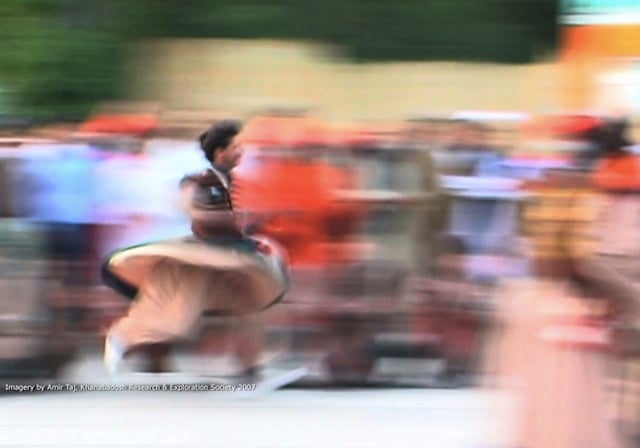
Khattak dance involves running and whirling. It is mainly performed in and around the Peshawar area of Pakistan.
Pashtun culture is mostly based on Pashtunwali and the usage of the Pashto language.
Pre-Islamic traditions, dating back to Alexander's defeat of the Persian Empire in 330 BC, possibly survived in the form of traditional dances, while literary styles and music reflect influence from the Persian tradition and regional musical instruments fused with localised variants and interpretation. Pashtun culture is a unique blend of native customs with some influences from South and Western Asia. Like other Muslims, Pashtuns celebrate Ramadan and Eid al-Fitr. Some also celebrate Nouruz
Pashtunwali
Pashtunwali (or Pakhtunwali) refers to an ancient self-governing tribal system that regulates nearly all aspects of Pashtun life ranging from community to personal level. One of the better known tenets is Melmastia, hospitality and asylum to all guests seeking help. Perceived injustice calls for Badal, swift revenge. Many aspects promote peaceful co-existence, such as Nanawati, the humble admission of guilt for a wrong committed, which should result in automatic forgiveness from the wronged party. These and other basic precepts of Pashtunwali continue to be followed by many Pashtuns, especially in rural areas.
Another prominent Pashtun institution is the loya jirga or 'grand council' of elected elders. Most decisions in tribal life are made by members of the jirga, which has been the main institution of authority that the largely egalitarian Pashtuns willingly acknowledge as a viable governing body.[103]
Pashto literature and poetry

Mahmud Tarzi, son of Ghulam Muhammad Tarzi, became the pioneer of Afghan journalism.
The majority of Pashtuns use Pashto as their native tongue, believed to belong to the Indo-Iranian language family,[104] and is spoken by up to 60 million people.[105][106] It is written in the Pashto-Arabic script and is divided into two main dialects, the southern "Pashto" and the northern "Pukhto". The language has ancient origins and bears similarities to extinct languages such as Avestan and Bactrian.[107] Its closest modern relatives may include Pamir languages, such as Shughni and Wakhi, and Ossetic. Pashto may have ancient legacy of borrowing vocabulary from neighbouring languages including such as Persian and Vedic Sanskrit. Modern borrowings come primarily from the English language.[108]
Fluency in Pashto is often the main determinant of group acceptance as to who is considered a Pashtun.
Pashtun nationalism emerged following the rise of Pashto poetry that linked language and ethnic identity. Pashto has national status in Afghanistan and regional status in neighboring Pakistan. In addition to their native tongue, many Pashtuns are fluent in Urdu, Dari, and English. Throughout their history, poets, prophets, kings and warriors have been among the most revered members of Pashtun society. Early written records of Pashto began to appear around the 16th century.
The earliest describes Sheikh Mali's conquest of Swat.[109] Pir Roshan is believed to have written a number of Pashto books while fighting with the Mughals. Pashtun scholars such as Abdul Hai Habibi and others believe that the earliest Pashto work dates back to Amir Kror Suri, and they use the writings found in Pata Khazana as proof. Amir Kror Suri, son of Amir Polad Suri, was an 8th-century folk hero and king from the Ghor region in Afghanistan.[110][111] However, this is disputed by several European experts due to lack of strong evidence.
The advent of poetry helped transition Pashto to the modern period.
Pashto literature gained significant prominence in the 20th century, with poetry by Ameer Hamza Shinwari who developed Pashto Ghazals.[112] In 1919, during the expanding of mass media, Mahmud Tarzi published Seraj-al-Akhbar, which became the first Pashto newspaper in Afghanistan. In 1977, Khan Roshan Khan wrote Tawarikh-e-Hafiz Rehmatkhani which contains the family trees and Pashtun tribal names. Some notable poets include Khushal Khan Khattak, Afzal Khan Khattak, Ajmal Khattak, Pareshan Khattak, Rahman Baba, Nazo Anaa, Hamza Shinwari, Ahmad Shah Durrani, Timur Shah Durrani, Shuja Shah Durrani, Ghulam Muhammad Tarzi, and Ghani Khan.[113][114]
Recently, Pashto literature has received increased patronage, but many Pashtuns continue to rely on oral tradition due to relatively low literacy rates and education. Pashtun society is also marked by some matriarchal tendencies.[115] Folktales involving reverence for Pashtun mothers and matriarchs are common and are passed down from parent to child, as is most Pashtun heritage, through a rich oral tradition that has survived the ravages of time.
Media and arts
Pashto media has expanded in the last decade, with a number of Pashto TV channels becoming available. Two of the popular ones are the Pakistan-based AVT Khyber and Pashto One. Pashtuns around the world, particularly those in Arab countries, watch these for entertainment purposes and to get latest news about their native areas.[116] Others are Afghanistan-based Shamshad TV, Radio Television Afghanistan, and Lemar TV, which has a special children's show called Baghch-e-Simsim. International news sources that provide Pashto programs include BBC and Voice of America.
Producers based in Peshawar have created Pashto-language films since the 1970s.
Pashtun performers remain avid participants in various physical forms of expression including dance, sword fighting, and other physical feats.
Perhaps the most common form of artistic expression can be seen in the various forms of Pashtun dances.
One of the most prominent dances is Attan, which has ancient roots. A rigorous exercise, Attan is performed as musicians play various native instruments including the dhol (drums), tablas (percussions), rubab (a bowed string instrument), and toola (wooden flute). With a rapid circular motion, dancers perform until no one is left dancing, similar to Sufi whirling dervishes. Numerous other dances are affiliated with various tribes notably from Pakistan including the Khattak Wal Atanrh (eponymously named after the Khattak tribe), Mahsood Wal Atanrh (which, in modern times, involves the juggling of loaded rifles), and Waziro Atanrh among others. A sub-type of the Khattak Wal Atanrh known as the Braghoni involves the use of up to three swords and requires great skill. Young women and girls often entertain at weddings with the Tumbal (tambourine).
Sports
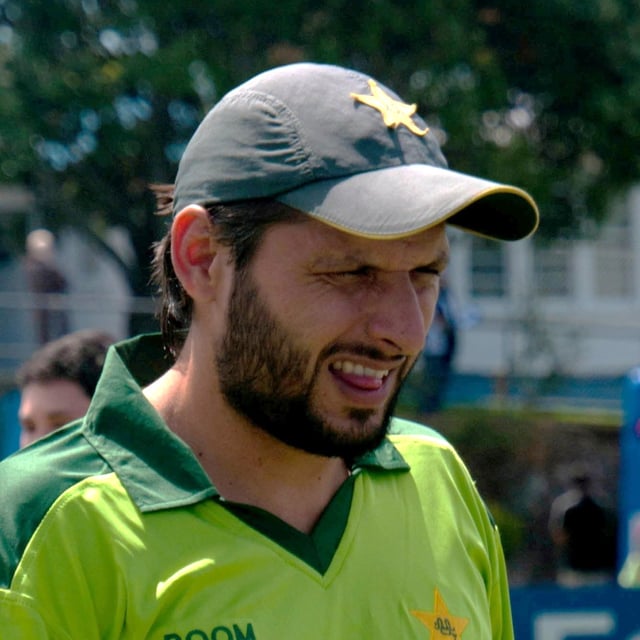
Shahid Afridi, former captain of the Pakistan national cricket team
The Afghanistan national cricket team, which is dominated by Pashtun players, was formed in the early 2000s.
One of the most popular sports among Pashtuns is cricket, which was introduced to South Asia during the early 18th century with the arrival of the British. Many Pashtuns have become prominent international cricketers in the Pakistan national cricket team, including Imran Khan, Shahid Afridi, Majid Khan, Misbah-ul-Haq, Younis Khan, Umar Gul, Junaid Khan, Fakhar Zaman, Mohammad Rizwan, Sahibzada Farhan, Usman Shinwari and Yasir Shah. Australian cricketer Fawad Ahmed is of Pakistani Pashtun origin who has played for the Australian national team.[117]
Football (soccer) is also one of the most popular sports among Pashtuns. The current captain of Pakistan national football team, Muhammad Essa, is an ethnic Pashtun. Other sports popular among Pashtuns may include polo, field hockey, volleyball, handball, basketball, golf, track and field, bodybuilding, weightlifting, wrestling (pehlwani), kayaking, horse racing, martial arts, boxing, skateboarding, bowling and chess.
Jahangir Khan and Jansher Khan became greatest professional squash players. Although now retired, they are engaged in promoting the sport through the Pakistan Squash Federation. Maria Toorpakai Wazir is the first female Pashtun squash player. Pakistan also produced other world champions of Pashtun origin: Hashim Khan, Roshan Khan, Azam Khan, Mo Khan and Qamar Zaman.In recent decades Hayatullah Khan Durrani, Pride of Performance legendary caver from Quetta, has been promoting mountaineering, rock climbing and Caving in Balochistan, Pakistan. Mohammad Abubakar Durrani International Canoeing shining star of Pakistan.
Snooker and billiards are played by young Pashtun men, mainly in urban areas where snooker clubs are found. Several prominent international recognized snooker players are from the Pashtun area, including Saleh Mohammed. Although traditionally very less involved in sports than boys, Pashtun girls sometimes play volleyball, basketball, football, and cricket, especially in urban areas.
Makha is a traditional archery sport in Khyber Pakhtunkhwa, played with a long arrow (gheshai) having a saucer shaped metallic plate at its distal end, and a long bow.
Religion

The Friday Mosque in Kandahar. Adjacent to it is the Shrine of the Cloak and the tomb of Ahmad Shah Durrani, the 18th century Pashtun conqueror who became the founding father of Afghanistan.

Men doing Islamic salat (praying) outside in the open in the Kunar Province of Afghanistan
The overwhelming majority of Pashtuns follow Sunni Islam, belonging to the Hanafi school of thought. There are some Shia Pashtun communities in the Federally Administered Tribal Areas (FATA) of Pakistan and in neighbouring northeastern section of Paktia province of Afghanistan. The Shias belong to the Turi tribe while the Bangash tribe is approximately 50% Shia and the rest Sunni, who are mainly found in and around the Parachinar, Kurram, Hangu, Kohat and Orakzai areas in Pakistan.[118]
Studies conducted among the Ghilji reveal strong links between tribal affiliation and membership in the larger ummah (Islamic community). Afghan historians believe that most Pashtuns are descendants of Qais Abdur Rashid, who is purported to have been an early convert to Islam and thus bequeathed the faith to the early Pashtun population.[17][64][119] The legend says that after Qais heard of the new religion of Islam, he travelled to meet Muhammad in Medina and returned to Afghanistan as a Muslim. He purportedly had four children: Sarban, Batan, Ghourghusht and Karlan. Before the Islamization of their territory, the Pashtuns likely followed various religions. Some may have been Buddhists and Hindus, while others Zoroastians, worshippers of the sun, or worshippers of Nana, with some adhering to Judaism and "local natural religions".[120][121] However, there is no conclusive evidence to these theories other than the fact that these were the religions practiced by the people in this region before the arrival of Islam in the 7th century.[122]
A legacy of Sufi activity may be found in some Pashtun regions, especially in the Khyber Pakhtunkhwa area, as evident in songs and dances. Many Pashtuns are prominent Ulema, Islamic scholars, such as Maulana Aazam an author of more than five hundred books including Tafasee of the Quran as Naqeeb Ut Tafaseer, Tafseer Ul Aazamain, Tafseer e Naqeebi and Noor Ut Tafaseer etc, as well as Muhammad Muhsin Khan who has helped translate the Noble Quran, Sahih Al-Bukhari and many other books to the English language.[123] Jamal-al-Din al-Afghani was a 19th-century Islamic ideologist and one of the founders of Islamic modernism. Although his ethnicity is disputed by some, he is widely accepted in the Afghanistan-Pakistan region as well as in the Arab world, as a Pashtun from the Kunar Province of Afghanistan. Like other non Arabic-speaking Muslims, many Pashtuns are able to read the Quran but not understand the Arabic language implicit in the holy text itself. Translations, especially in English, are scarcely far and in between understood or distributed. This paradox has contributed to the spread of different versions of religious practices and Wahabism, as well as political Islamism (including movements such as the Taliban) having a key presence in Pashtun society. In order to counter radicalisation and fundamentalism, the United States began spreading its influence in Pashtun areas.[124][125] Many Pashtuns want to reclaim their identity from being lumped in with the Taliban and international terrorism, which is not directly linked with Pashtun culture and history.[126]
Lastly, little information is available on non-Muslim as there is limited data regarding irreligious groups and minorities, especially since many of the Hindu and Sikh Pashtuns migrated from Khyber Pakhtunkhwa after the partition of India and later, after the rise of the Taliban.[127][128] There is a community of Pashtun Sikhs in Peshawar, Parachinar, and Orakzai Agency of FATA, Pakistan.[129]
A small Pashtun Hindu community, known as the Sheen Khalai meaning 'blue skinned' (referring to the color of Pashtun women's facial tattoos), migrated to Unniara, Rajasthan, India after partition.[15] Prior to 1947, the community resided in the Quetta, Loralai and Maikhter regions of the British Indian province of Baluchistan.[15] Today, they continue to speak Pashto and celebrate Pashtun culture through the Attan dance. They are mainly members of the Pashtun Kakar tribe.[15]
Women
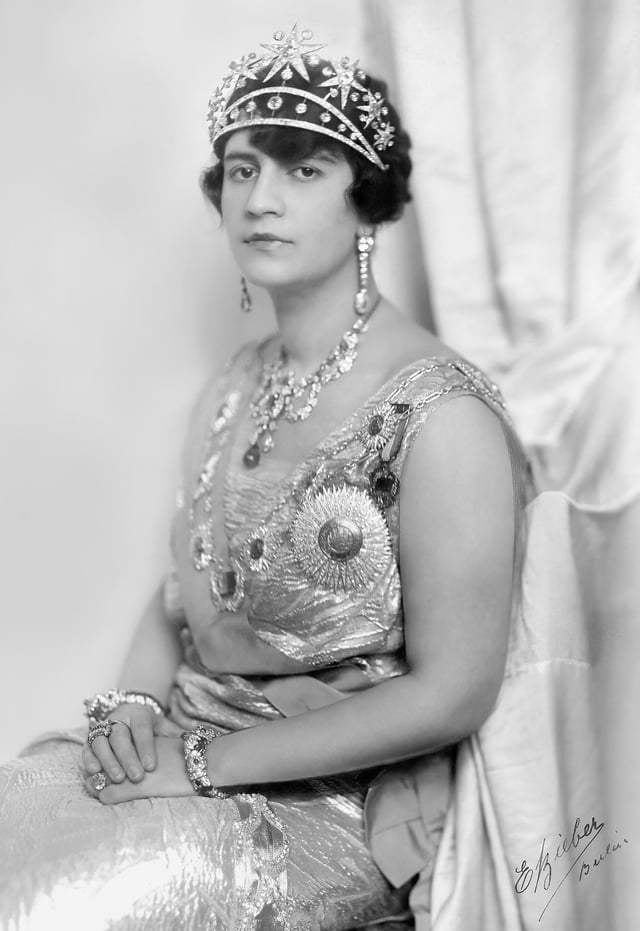
Queen Soraya of Afghanistan

Zarine Khan, Indian model and actress in Bollywood films
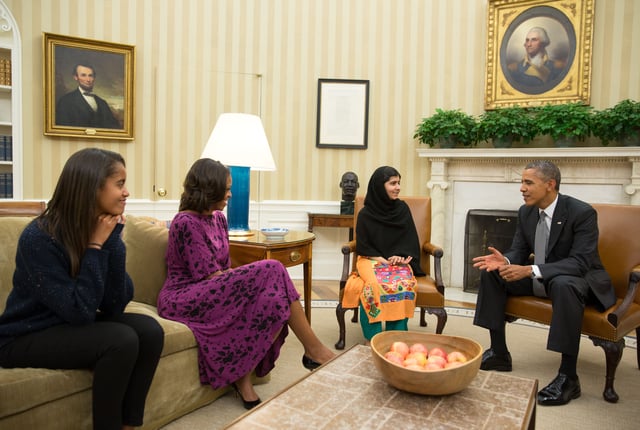
Malala Yousafzai, Pakistani schoolgirl with U.S. President Barack Obama and family. She won the 2014 Nobel Peace Prize.
In Pashtun society there are three levels of women's leadership and legislative authority: the national level, the village level, and the family level.
The national level includes women such as Nazo Tokhi (Nazo Anaa), Zarghona Anaa, and Malalai of Maiwand. Nazo Anaa was a prominent 17th century Pashto poet and an educated Pashtun woman who eventually became the "Mother of Afghan Nationalism" after gaining authority through her poetry and upholding of the Pashtunwali code. She used the Pashtunwali law to unite the Pashtun tribes against their Persian enemies. Her cause was picked up in the early 18th century by Zarghona Anaa, the mother of Ahmad Shah Durrani.[130]
The lives of Pashtun women vary from those who reside in conservative rural areas, such as the tribal belt, to those found in relatively freer urban centres.[131] At the village level, the female village leader is called "qaryadar". Her duties may include witnessing women's ceremonies, mobilising women to practice religious festivals, preparing the female dead for burial, and performing services for deceased women. She also arranges marriages for her own family and arbitrates conflicts for men and women.[130] Though many Pashtun women remain tribal and illiterate, others have become educated and gainfully employed.[131]
In Afghanistan, the decades of war and the rise of the Taliban caused considerable hardship among Pashtun women, as many of their rights were curtailed by a rigid interpretation of Islamic law. The difficult lives of Afghan female refugees gained considerable notoriety with the iconic image of the so-called "Afghan Girl" (Sharbat Gula) depicted on the June 1985 cover of National Geographic magazine.[132]
Modern social reform for Pashtun women began in the early 20th century, when Queen Soraya Tarzi of Afghanistan made rapid reforms to improve women's lives and their position in the family. She was the only woman to appear on the list of rulers in Afghanistan. Credited with having been one of the first and most powerful Afghan and Muslim female activists. Her advocacy of social reforms for women led to a protest and contributed to the ultimate demise of King Amanullah's reign in 1929.[133] In 1942, Madhubala (Mumtaz Jehan), the Marilyn Monroe of India, entered the Bollywood film industry. Bollywood blockbusters of 1970s and 1980s starred Parveen Babi, who hailed from the lineage of Gujarat's historical Pathan community: the royal Babi Dynasty. Other Indian actresses and models, such as Zarine Khan, continue to work in the industry.[134] Civil rights remained an important issue during the 1970s, as feminist leader Meena Keshwar Kamal campaigned for women's rights and founded the Revolutionary Association of the Women of Afghanistan (RAWA) in the 1977.[135]
Pashtun women these days vary from the traditional housewives who live in seclusion to urban workers, some of whom seek or have attained parity with men.[131] But due to numerous social hurdles, the literacy rate remains considerably lower for Pashtun females than for males.[136] Abuse against women is present and increasingly being challenged by women's rights organisations which find themselves struggling with conservative religious groups as well as government officials in both Pakistan and Afghanistan. According to a 1992 book, "a powerful ethic of forbearance severely limits the ability of traditional Pashtun women to mitigate the suffering they acknowledge in their lives."[137]
Despite obstacles, many Pashtun women have begun a process of slow change.
A rich oral tradition and resurgence of poetry has inspired many Pashtun women seeking to learn to read and write.[115] Further challenging the status quo, Vida Samadzai was selected as Miss Afghanistan in 2003, a feat that was received with a mixture of support from those who back the individual rights of women and those who view such displays as anti-traditionalist and un-Islamic. Some Pashtun women have attained political office in Pakistan. In Afghanistan, following recent elections, the proportion of female political representatives is one of the highest in the world.[138] A number of Pashtun women are found as TV hosts, journalists and actors.[116] Khatol Mohammadzai serves as Brigadier general in the military of Afghanistan, another Pashtun female became a fighter pilot in the Pakistan Air Force.[139] Some other notable Pashtun women include Suhaila Seddiqi, Zeenat Karzai, Shukria Barakzai, Fauzia Gailani, Naghma, Najiba Faiz, Tabassum Adnan, Sana Safi, Malalai Kakar, Malala Yousafzai, and the late Ghazala Javed.
Pashtun women often have their legal rights curtailed in favour of their husbands or male relatives.
For example, though women are officially allowed to vote in Afghanistan and Pakistan, some have been kept away from ballot boxes by males.[131] Another tradition that persists is swara (a form of child marriage), which was declared illegal in Pakistan in 2000 but continues in some parts.[141] Substantial work remains for Pashtun women to gain equal rights with men, who remain disproportionately dominant in most aspects of Pashtun society. Human rights organisations continue to struggle for greater women's rights, such as the Afghan Women's Network and the Aurat Foundation in Pakistan which aims to protect women from domestic violence.
See also
List of Pashtun empires and dynasties